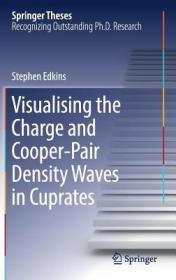
现货Visualising the Charge and Cooper-Pair Density Waves in Cuprates (2017)[9783319659749]
¥ 1114 九五品
库存3件
上海宝山
认证卖家担保交易快速发货售后保障
作者Edkins, Stephen
出版社Springer
ISBN9783319659749
出版时间2017-09
装帧精装
纸张其他
页数187页
正文语种英语
上书时间2023-08-14
- 最新上架
商品详情
- 品相描述:九五品
- 商品描述
- This thesis reports on the use of scanning tunnelling microscopy to elucidate the atomic-scale electronic structure of a charge density wave, revealing that it has a d-symmetry form factor, hitherto unobserved in nature. It then details the development of an entirely new class of scanned probe: the scanning Josephson tunnelling microscope. This scans the Josephson junction formed between a cuprate superconducting microscope tip and the surface of a cuprate sample, thereby imaging the superfluid density of the sample with nanometer resolution. This novel method is used to establish the existence of a spatially modulated superconducting condensate, something postulated theoretically over half a century ago but never previously observed.
— 没有更多了 —
![现货Visualising the Charge and Cooper-Pair Density Waves in Cuprates (2017)[9783319659749]](https://www0.kfzimg.com/sw/kfz-cos/kfzimg/17733071/4f6ad8cf2489f491_b.jpg)

![现货Materials and Technologies of Modern Production[9783036401683]](https://www0.kfzimg.com/sw/kfz-cos/kfzimg/17733071/5fd2824531e165d7_s.jpg)
![现货Introduction to Container Ship Operations and Onboard Safety[9781032155425]](https://www0.kfzimg.com/sw/kfz-cos/kfzimg/17733071/58b7ff43ef7909ee_s.jpg)
![现货Electrophosphorescent Materials and Devices[9789814877343]](https://www0.kfzimg.com/sw/kfz-cos/kfzimg/17733071/18cc1d77bcb7b488_s.jpg)
![现货Organic Semiconductors for Optoelectronics[9781119146100]](https://www0.kfzimg.com/sw/kfz-cos/kfzimg/17733071/24c85a750c708964_s.jpg)
![现货Advances in Food Rheology and Its Applications[9780081004319]](https://www0.kfzimg.com/sw/kfz-cos/kfzimg/17733071/e0c11603c9119d4d_s.jpg)
![现货Advanced Materials and Sustainable Technologies[9783035727562]](https://www0.kfzimg.com/sw/kfz-cos/kfzimg/17733071/dced675333874c48_s.jpg)
![现货Advanced Materials and Manufacturing Engineering II[9783035712681]](https://www0.kfzimg.com/sw/kfz-cos/kfzimg/17733071/660ccfae75fa8d3e_s.jpg)
![现货Materials in Machinery and Construction[9783035718119]](https://www0.kfzimg.com/sw/kfz-cos/kfzimg/17733071/6f402060775e9daa_s.jpg)
![现货Cereal Grain Quality (Softcover Reprint of the Original 1st 1996)[9789401071772]](https://www0.kfzimg.com/sw/kfz-cos/kfzimg/17733071/f93ca1c96a97403a_s.jpg)
![现货Visualising the Charge and Cooper-Pair Density Waves in Cuprates (2017)[9783319659749]](/dist/img/error.jpg)
以下为对购买帮助不大的评价